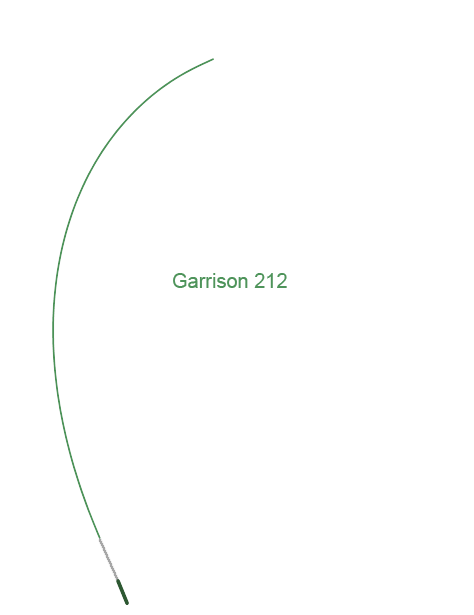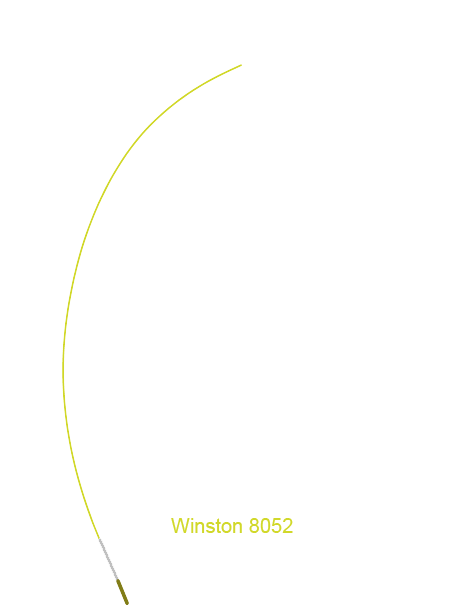
| Classic Rod Actions and Speed | |
|
|
||||||
|
The Gierach/Best model from
Michael Clark is another faster action rod. Notice it flexes slightly more in the lower 1/3 and less in the mid section
than the Dickerson 8013 and it has a quick softening
near the tip giving it a distinctive and sharper curve.
I usually wouldn't include a taper from another living rodmaker but I figured that many people would be familiar with Mr. Gierach's writings so including a rod that he talks about and indirectly compares to a progressive action Garrison rod, might give some extra insight to rod actions. I will admit I'm not certain this taper is the one his discusses but given this is his signature model I suspect it, or a very similar one, is the rod he favors and talks about in "Fishing Bamboo" and other books. |
||||||
|
|
||||||
|
The "Dickerson 8013" has several different variations. Most of these tapers were measured
directly from existing rods, and because Mr. Dickerson tended to change his tapers quite
a lot without changing the name, we have numerous, often significantly different, versions
that are called the same thing. In general, if it was an 8'0" two piece rod that used a size
13/64 ferrule, it was labeled an 8013.
One of these, the Dickerson 8013 (1951), is also typically considered to be faster, or at least medium-fast, action. It has more flex in the lower part of the rod than the other 8013 shown. However, it again quickly softens exhibiting the tip flex that is characteristic of a faster action taper. The difficulty in describing these obviously different actions comes when trying to label both of them as, say, 'fast' or 'medium-fast'. The Dickerson 8013 (1951) is distinctly softer overall than the Dickerson 8013 yet they both exhibit similar bend characteristics, those of a 'faster' action rod. So we are trying to describe two (at least) characteristics - how the rod flexes and how much it flexes - with a single term like 'medium-fast' or 'fast'. |
||||||
|
|
||||||
|
Here is where things start to get both interesting and confusing.
Lets take the exact same Dickerson 8013 (1951) rod but lets cast it with a 4 weight fly line instead of the 5 weight line. The result is shown as the rod Dickerson 8013 (1951) 4wt. Again, this is the exact same rod/taper as the Dickerson 8013 (1951) we're just simulating it with a 4wt line instead of a 5wt line. Notice that the Dickerson 8013 (1951) 4wt deflection is much closer to that of the Dickerson 8013. So what does that mean? Does it mean that the Dickerson 8013 (1951) is really a 4wt rod and is overlined with a 5wt line, or perhaps the Dickerson 8013 is underlined with a 5wt as a 6wt line would cause it to flex deeper and have it much more closely resemble the Dickerson 8013 (1951). This is a very good example of the subjectivity in designating line weights for various rods. The Dickerson 8013 (1951) will obviously cast a 5wt line just fine, as it will a 4wt. A 3wt line would straighten it even further but might actually appeal to those who really like a stiff rod and are casting a lot of line. Or alternately, for those who prefer slower, more full flexing rods, going to a 6wt line would cause it to bend even more than with the 5wt as shown. This is one reason why the line weight inscribed on a rod is not a completely objective thing. One person might like how a rod acts with one weight or type/taper of fly line while someone else prefers that same rod with a different weight or type/taper line, or one line weight might work better for long dry fly casts while a different line weight might feel better casting in close or roll casting. |
||||||
|
||||||
|
|
|
||||||
| The Leonard 50df is another rod that is considered faster, dry fly action (hence the 'df'). Notice it flexes even more in the lower section than all the previous rods yet still exhibits a somewhat sharper bend near the tip. Its softer, yet still considered fast. | ||||||
|
|
||||||
| Compare the faster action rods to one that has a more medium or progressive action like the Garrison 212. This rod flexes deeper into the butt yet has a comparativley stiffer mid and tip so it doesn't display the pronounced deeper curve in the upper part of the rod of the faster action rods. In short this style of rod exhibits a more even bend overall and is therefore often called progressive action. | ||||||
|
|
||||||
| This Winston 8052 is what I would consider to be on the slower end of rod action. It flexes very deep. As you progress up the rod it stiffens in the middle which can be clearly seen as the severity of the bend lessens at about the 1/3 point. Though the bend does increase slightly, it doesn't exhibit any really significant bending near the tip like a faster rod. Some call this style of taper a 'wet fly' taper. | ||||||
|
|
||||||
|
Here we have a typical parabolic action rod. This is a Hardy
but Petzon and Payne parabolics are overall very similar. Notice the deep flex with very
little bending throughout the rest of the rod, especially the tip.
As you can imagine, these rods feel a bit like they are hinged right above the grip and can easily cast a lot of line. They also take a more accurate timing during the cast given how much of the rod is moving plus there isn't any significant flex in the tip to forgive small flaws. |
||||||
|
|
||||||
|
This is a Paul H Young Para 15 (Kellum) which is also considered
a parabolic rod. The sigificant difference is that the upper 1/3 or so of the
Young Para 15 is more flexible than the
Hardy CC de France parabolic; this softening makes the Young
parabolics that are like this one better at short range casting and slightly more forgiving during
longer casts. In general, the parabolic rod is considered 'more parabolic' the softer the butt section.
The Young Para 15 (Kellum) can also be made with a 'wet tip' - one that is stiffer - that makes the rod closer to the Hardy. There are also other variations of the Para 15 but the one shown here is taken directly from the Young beveler setup and is the rod discussed in Schwiebert's "Trout" (though he calls it "KT Keller"). One drawback to parabolic action rods is that in order to get the entire rod bending so easily they have to have lighter butt sections than faster action rods of an equivalent line weight. This can mean you don't have as much 'wood' to play fish, especially with stronger fish or in faster current. |
||||||
|
||||||
|
To directly compare these and a handful of other classic rods, check out the Deflection Comparison page. |

















